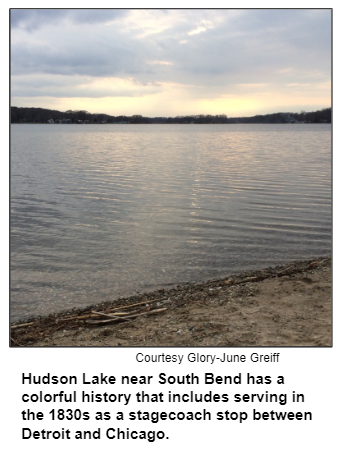May 11, 2019
(May 4, 2019) 
In LaPorte County, Hudson Lake has a colorful history that includes, during the 1830s, a cluster of cabins and shops on its shores that served as a stagecoach stop between nascent Detroit and Chicago.
Today, Olin Lake in LaGrange County has the largest undeveloped shoreline of all of Indiana's natural lakes.
They are among the lakes in northern Indiana that we explore during a show with a special format. Nelson's guests are a series of "lake correspondents" who phone in with reports about the heritage of natural lakes in northern Indiana.
As we noted during a show last summer about our state's two largest natural lakes - Lake Wawasee and Lake Maxinkuckee - most of the lakes in northern Indiana have glacial origins. Large lakes in southern Indiana, including Lake Monroe, are man-made.
Our lake correspondents include:
- Jim Somers and Flaim Cupp, co-authors of the 2011 book A History of Lake James; both of their families are long-term property owners at the lake, which covers 1,229 acres and reaches a depth of 88 feet. They report that of about 800 cottages on Lake James today, about one-fourth are owned by year-round residents like Jim and Flaim.
Public historian Glory-June Greiff, who grew up at Hudson Lake. "LaPorte County is so lake-filled that you're bound to run into one just wandering the roads," she notes. "The county seat of LaPorte has at least five within its city limits."
- Botanist Michael Homoya, who retired from the Indiana Department of Natural Resources. He shares insights about Olin Lake, which has a shoreline of about 2 miles in length. "Interesting wetlands border the lake, including a 'fen'," Michael reports, adding that a fen is a "natural community that is saturated with groundwater seepage flowing in a diffuse matter."
- And Jim Nierman, who discusses Bass Lake, the state's third largest natural lake. Jim does commentary on history tours aboard trams that go around the lake, which is located in Starke County in far-northwest Indiana. Jim, who is 77, has been visiting the lake since he was a teenager during the 1950s. For more than 100 years, Bass Lake has been an enticing "escape," particularly for Chicago-area residents.
On the shore of Lake James, Pokagon State Park was established as an Indiana State Park in the 1920s, taking its name from illustrious leaders of the Potawatomi, a Native American tribe that once fished, hunted and lived across northern Indiana. During the 1920s, '30s and '40s, Big Band music attracted thousands of patrons to Lake James, according to Jim and Flaim. Motorboat racing has been a popular attraction for generations of lake-goers.
At Hudson Lake, the 1830s cluster of cabins was called Lakeport and, according to Glory-June, "vied unsuccessfully to become the county seat." She reports that 100 years later, Hudson Lake was a "happening place" again, with a casino (featuring performers such as jazz great Bix Beiderbecke) adjacent to the tracks of the South Shore Railroad running between South Bend and Chicago.
"Today," she says, "Hudson Lake is quiet, basking in its history."
Lake James, in contrast, is the site of scores of events, including sailboat races and an annual antique boat and car show organized by the Lake James Association. The association also presents "Centennial Cottage" awards to lake homes that, as Jim and Flaim put it, "have retained their original flavor for more than 100 years."
Bledsoe's Beach at Lake James - named after brothers who built a dance hall in 1919 - is often a hub of activity. During the 1960s, WOWO, an AM radio station based in Fort Wayne, broadcast live music during sock hops and record hops at the beach. Boat parades on holiday weekends and a seaplane "fly-in" at Pokagon State Park continue to this day.